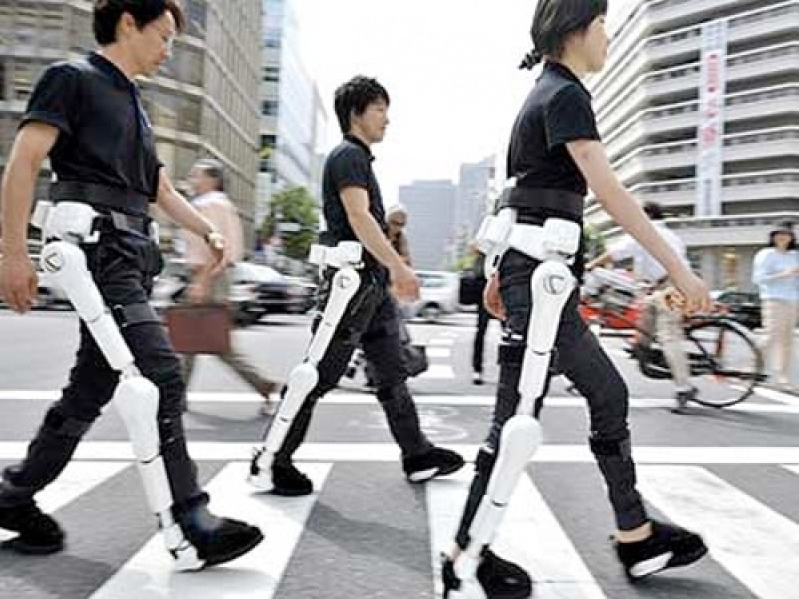
Swiss sensory motor scientists are hoping to inspire a new generation of more flexible, less constraining, powered exoskeletons that improve the lives of the severely disabled and paralyzed.
Metal exoskeleton suits worn outside the body, delivering energy for limb movement, are becoming more widespread, helping survivors of strokes, spinal cord injuries, and other lower extremity weaknesses to walk again.
Yet they are far from perfect solutions. A patient's joints can be misaligned with those of the exoskeleton, thus constraining the wearer's walking. They are also usually bulky, making climbing stairs impossible, while the limitations of their joint mechanisms makes anything other than walking in a straight line difficult, slow, and inefficient, and in some cases unachievable.
ETH Zurich (Swiss Federal institute of Technology) researcher Volker Bartenbach told Reuters that a prototype developed at the institute's Sensory Motor Laboratory allows users far more freedom.
"Hopefully we will build systems that allow you to do more tasks," he said. "Besides walking in a straight line, you might be able to walk sideways in front of your kitchen counter or something like that, to walk stairs up and down. Also to turn round on the spot, so they need different joints, they need different degrees of freedom and if we had a system that was powerful enough to support you but also less constraining to allow you those movements you would be able to do such movements, even if you were a paraplegic or handicapped person."
Bartenbach and professor of sensory motor systems, Robert Riener, are seeking to replicate the natural kinematics of human lower limbs, in an attempt to improve the type of exoskeleton currently being manufactured.
Pointing to one of the exoskeleton hip joints, Bartenbach demonstrated to Reuters how the device could allow users to move their joint in a variety of ways. "We have here the hip joint, so if I move my leg like this the exoskeleton provides this degree of freedom. The same, different degree of freedom is, for example, the adduction abduction, so if I spread my leg to the side and this is also provided here by the exoskeleton, by the joint, so if I'm inside I can still perform this movement," he said.
He added: "The human also has internal, external rotation, so we can rotate our hip around this axis, which we need for example if you turn around on the spot - and here you see we are testing a technical solution, how to reproduce it, how to allow this movement. What you can see here is this four bar linkage mechanism. If you have multiple joints connected in a certain way then we allow the leg inside to still perform this movement."
Bartenbach wants to build an exoskeleton that is an alternative to a wheelchair for a spinal paralysis patient.
The lab is also working on a different approach for assistive devices, a so called soft exosuit. These robotic devices rely on force transmission through textiles and can be worn like regular clothes, yet provide sufficient assistance to support the wearer during specific motions and ideally feature no rigid structures like traditional exoskeletons. The lack of a rigid structure avoids, or at least reduces, many of the negative effects rooted in the heaviness and high inertia of the structure and actuators, as well as in the bulky design and kinematic constraints.
The team has already developed the second generation of a gait training robot called Lokomat, in cooperation with commercial company Hocoma. It consists of an exoskeleton attached to a treadmill, while a variety of cameras track the user's limb movements. Lokomart is used to help those with gait paralysis walk again.
Riener says patients using Lokomat undertake training considerably more intensive than conventional gait therapies. "They (patients) have to walk a lot, they have to do intensive training and walk on that treadmill while being body weight supported and the robot guides the legs and enables them to walk, which they could not do at all without this device," he said.
Riener added: "The only alternative to this device in gait training is the application of manual gait therapy where two or even three therapists are guiding the leg and helping the patients to walk. However, that's personally very intensive and the training duration is limited. With the robot the patients can train much longer and much more intensive."
The professor says that, if developed on a commercial scale, the process will reduce the costs of healthcare, while intensifying recovery times.
Riener is organizing next year's Cybathlon, an annual event organized by ETH Zurich in which people with a variety of disabilities compete to finish a variety of everyday tasks that are particularly difficult for their individual handicap. For instance, patients with prosthetic upper limbs will perform tasks such as carrying shopping bags or preparing a meal, while those with lower limb paralysis will be asked to undertake activities such as climbing stairs, using a robotic exoskeleton for assistance.
According to the ETH Zurich website, "through the organization of the Cybathlon we want to help removing barriers between the public, people with disabilities and science."
The event takes place in October 2016.




![[Exclusive] Watoto Asia Director Rev. Sunny Cheng: Bringing Life-Changing Education from Africa!](https://www.gospelherald.com/media/cache/thumbnail/7/23/72332sp_273w_150h_1x_1y.jpg)


